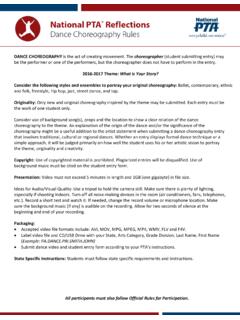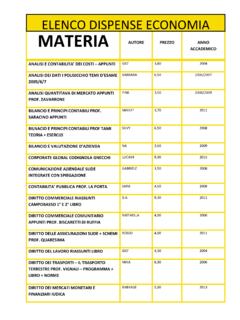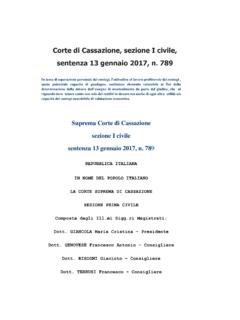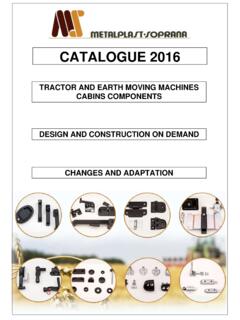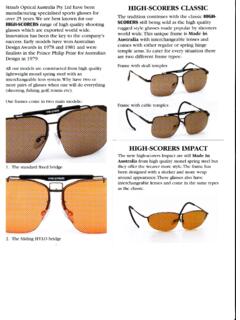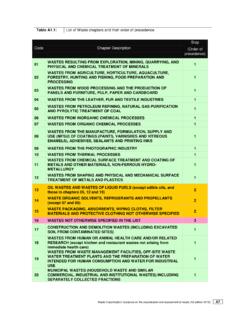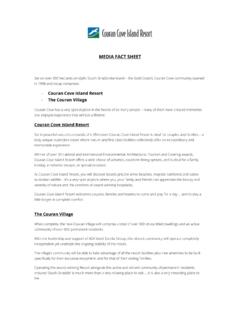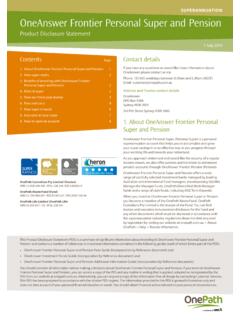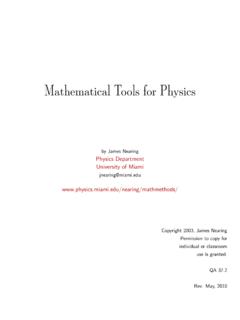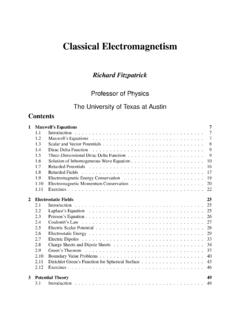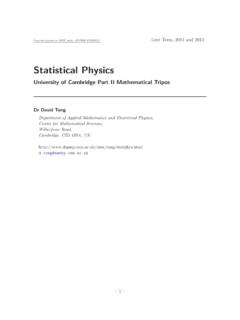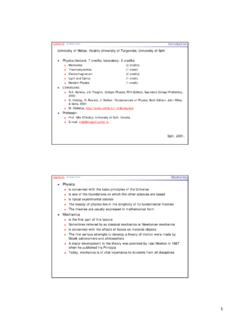Transcription of Solved Problems in Classical Mechanics
1 Solved Problems in Classical MechanicsThis page intentionally left blank Solved Problems in ClassicalMechanicsAnalytical and numerical solutionswith de Lange and J. PierrusSchool of Physics, University of KwaZulu-Natal,Pietermaritzburg, South Africa13 Great Clarendon Street, Oxfordox26dpOxford University Press is a department of the University of furthers the University s objective of excellence in research, scholarship,and education by publishing worldwide inOxford New YorkAuckland Cape Town Dar es Salaam Hong Kong KarachiKuala Lumpur Madrid Melbourne Mexico City NairobiNew Delhi Shanghai Taipei TorontoWith offices inArgentina Austria Brazil Chile Czech Republic France GreeceGuatemala Hungary Italy Japan Poland Portugal SingaporeSouth Korea Switzerland Thailand Turkey Ukraine VietnamOxford is a registered trade mark of Oxford University Pressin the UK and in certain other countriesPublished in the United Statesby Oxford University Press Inc.
2 , New Yorkc de Lange and J. Pierrus 2010 The moral rights of the authors have been assertedDatabase right Oxford University Press (maker)First published 2010 All rights reserved. No part of this publication may be reproduced,stored in a retrieval system, or transmitted, in any form or by any means,without the prior permission in writing of Oxford University Press,or as expressly permitted by law, or under terms agreed with the appropriatereprographics rights organization. Enquiries concerning reproductionoutside the scope of the above should be sent to the Rights Department,Oxford University Press, at the address aboveYou must not circulate this book in any other binding or coverand you must impose the same condition on any acquirerBritish Library Cataloguing in Publication DataData availableLibrary of Congress Cataloging in Publication DataData availableTypeset by SPI Publisher Services, Pondicherry, IndiaPrinted in Great Britainon acid-free paper byCPI Antony Rowe, Chippenham, WiltshireISBN 978 0 19 958252 5 (Hbk)978 0 19 958251 8 (Pbk)
3 13579108642 PrefaceIt is in the study of Classical Mechanics that we first encounter many of the basicingredients that are essential to our understanding of the physical universe. Theconcepts include statements concerning space and time, velocity, acceleration, mass,momentum and force, and then an equation of motion and the indispensable lawof action and reaction all set (initially) in the background of an inertial frame ofreference. Units for length, time and mass are introduced and the sanctity of thebalance of units in any physical equation (dimensional analysis) is stressed. Referenceis also made to the task of measuring these units metrology, which has become suchan astonishing rewards of this study are considerable.
4 For example, one comes toappreciate Newton s great achievement that the dynamics of the Classical universecan be understood via the solutions of differential equations and this leads onto questions regarding determinism and the effects of even small uncertainties ordisturbances. One learns further that even when Newton s dynamics fails, many ofthe concepts remain indispensable and some of its conclusions retain their validity such as the conservation laws for momentum, angular momentum and energy, and theconnection between conservation and symmetry and one discusses the domain ofapplicability of the theory. Along the way, a student encounters techniques such asthe use of vector calculus that permeate much of physics from electromagnetism toquantum this is familiar to lecturers who teach physics at universities; hence the emphasison undergraduate and graduate courses in Classical Mechanics , and the variety ofexcellent textbooks on the subject.
5 It has, furthermore, been recognized that trainingin this and related branches of physics is useful also to students whose careers willtake them outside physics. It seems that here the problem-solving abilities that physicsstudents develop stand them in good stead and make them desirable book is intended to assist students in acquiring such analytical andcomputational skills. It should be useful for self-study and also to lecturers andstudents in Mechanics courses where the emphasis is on problem solving, andformal lectures are kept to a minimum. In our experience, students respond well to thisapproach. After all, the rudiments of the subject can be presented quite succinctly (aswe have endeavoured to do in Chapter 1) and, where necessary, details can be filledin using a suitable regard to the format of this book: apart from the introductory chapter, itconsists entirely of questions and solutions on various topics in Classical mechanicsthat are usually encountered during the first few years of university study.
6 It is Solved Problems in Classical Mechanicssuggested that a student first attempt a question with the solution covered, andonly consult the solution for help where necessary. Both analytical and numerical(computer) techniques are used, as appropriate, in obtaining and analyzing of the numerical questions are suitable for project work in computational physics(see the Appendix). Most solutions are followed by a set of comments that are intendedto stimulate inductive reasoning (additional analysis of the problem, its possible ex-tensions and further significance), and sometimes to mention literature we have foundhelpful and interesting. We have included questions on bits of theory for topics wherestudents initially encounter difficulty such as the harmonic oscillator and the theoryof mechanical energy because this can be useful, both in revising and cementingideas and in building mathematical ability that the reader should have consists mainly of thefollowing: an elementary knowledge of functions their roots, turning points, asymp-totic values and graphs including the standard functions of physics (polynomial,trigonometric, exponential, logarithmic, and rational); the differential and integralcalculus (including partial differentiation); and elementary vector analysis.
7 Also, someknowledge of elementary Mechanics and general physics is desirable, although theextent to which this is necessary will depend on the proclivities of the our computer calculations we useMathematicaR , version In each instancethe necessary code (referred to as a notebook) is provided in a shadebox in the that include the interactiveManipulatefunction are given in Chapters6, 10, 11 and 13 (and are listed in the Appendix). They enable the reader to observemotion on a computer screen, and to study the effects of changing relevant reader without prior knowledge ofMathematicashould consult the tutorial( First Five Minutes withMathematica ) and the on-line Help. Also, various usefultutorials can be downloaded from the website All graphs ofnumerical results have been drawn to scale using our analytical solutions we have tried to strike a balance between burdening thereader with too much detail and not heeding Littlewood s dictum that two trivialitiesomitted can add up to an impasse.
8 In this regard it is probably not possible to satisfyall readers, but we hope that even tentative ones will soon be able to discern footprintsin the mist. After all, it is well worth the effort to learn that (on some level) the rulesof the universe are simple, and to begin to enjoy the unreasonable effectiveness ofmathematics in the natural sciences (Wigner).Finally, we thank Robert Lindebaum and Allard Welter for their assistance withour computer queries and also Roger Raab for helpful , South AfricaO. L. de LangeJanuary 2010J. PierrusContents1 Introduction12 Miscellanea113 One-dimensional motion304 Linear oscillations605 Energy and potentials926 Momentum and angular momentum1277 Motion in two and three dimensions1578 Spherically symmetric potentials2169 The Coulomb and oscillator problems26310 Two-body problems28611 Multi-particle systems32512 Rigid bodies39913 Non-linear oscillations45414 Translation and rotation of the reference frame51815 The relativity principle and some of its consequences557 Appendix588 Index590 This page intentionally left blank 1 IntroductionThe following outline of the rudiments of Classical Mechanics provides the backgroundthat is necessary in order to use this book.
9 For the reader who finds our presentationtoo brief, there are several excellent books that expound on these basics, such as thoselisted below.[1 4] Kinematics and dynamics of a single particleThe goal of Classical Mechanics is to provide a quantitative description of the motionof physical objects. Like any physical theory, Mechanics is a blend of definitions andpostulates. In describing this theory it is convenient to first introduce the concept ofa point object (a particle) and to start by considering the motion of a single this end one must make an assumption concerning the geometry of space. InNewtonian dynamics it is assumed that space is three-dimensional and is, space is spanned by the three coordinates of a Cartesian system; the distancebetween any two points is given in terms of their coordinates by Pythagoras stheorem, and the familiar geometric and algebraic rules of vector analysis apply.
10 Itis also assumed at least in non-relativistic physics that time is independent ofspace. Furthermore, it is supposed that space and time are sufficiently continuousthat the differential and integral calculus can be applied. A helpful discussion of thesetopicsisgiveninGriffiths sbook.[2]With this background, one selects a coordinate system. Often, this is a rectangularor Cartesian system consisting of an arbitrarily chosen coordinate originOand threeorthogonal axes, but in practice any convenient system can be used (spherical, cylin-drical, etc.). The position of a particle relative to this coordinate system is specified bya vector function of time the position vectorr(t). An equation forr(t)is known asthe trajectory of the particle, and finding the trajectory is the goal mentioned terms ofr(t)we define two indispensable kinematic quantities for the particle:the velocityv(t), which is the time rate of change of the position vector,[1]L.
